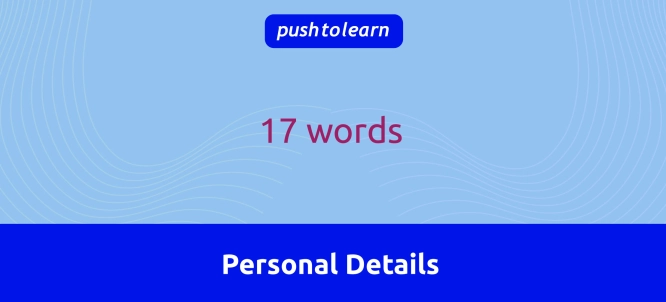by PushtoLearn
Personal Details
Table of Contents
Personal Details - Exercise
This exercise focuses on vocabulary about Personal Details
Basic Contact Information
Address
-
Definition: The specific location where a person lives or works.
-
Example: “My address is 123 Maple Street.”
Tips:
-
Start with the building number, followed by the street name, city, and postal code.
-
In English-speaking countries, addresses are written in a specific order, usually from smallest (house number) to largest (city or country).
Common Mistakes:
-
Incorrect order: Avoid reversing the order, such as writing the city before the street.
-
Missing post code: Always include the postal code for accuracy.
FAQ:
Do I need to include the country in my address?
Yes, when sharing your address internationally, include your country.
Email Address
-
Definition: An online address used for electronic communication.
-
Example: “My email address is john.doe@example.com.”
Tips:
-
Use "dot" for the period (.) and "at" for the @ symbol when reading it out loud.
-
In emails, letters are usually lowercase.
Common Mistakes:
-
Mixing uppercase and lowercase: Emails are not case-sensitive, but they are typically written in lowercase.
-
Confusing “dot” and “at”: When sharing your email, be clear and say "dot" for (.) and "at" for (@).
FAQ:
How do I pronounce symbols in my email address?
Use “dot” for periods (.), “at” for @, and “hyphen” for dashes (-).
Emergency Contact Number
-
Definition: A phone number used to reach someone in case of an emergency.
-
Example: “My emergency contact is my brother, at 555-6789.”
Tips:
-
Choose someone close to you, like a family member or close friend.
-
Many workplaces require this number on forms.
Common Mistakes:
-
Forgetting to update: Make sure your emergency contact information is current.
-
Providing only a name: Remember to give both a name and a contact number.
FAQ:
Why is an emergency contact number needed?
It’s important in case of accidents or emergencies, so that someone can reach your family or friend.

Personal Information
First Name
-
Definition: The name given to a person at birth, often used by friends and family.
-
Example: "My first name is Maria."
Tips:
-
In formal settings, use your full name (first name + surname).
-
Your first name is also called your “given name.”
Common Mistakes:
-
Using only a nickname: For official forms, use your full first name, not a nickname.
-
Confusing first name and surname: Remember, the first name comes before the surname.
FAQ:
Should I write my nickname or my full first name?
Write your full first name on official documents, not a nickname.
Surname
-
Definition: The family name or last name.
-
Example: "My surname is Smith."
Tips:
-
Use your surname after your first name when giving your full name (e.g., “Maria Smith”).
-
In formal situations, refer to others by their surname with a title, like “Mr. Smith.”
Common Mistakes:
-
Not using a title: In business settings, it’s polite to use a title with the surname.
-
Mixing up surname and first name order: Ensure you don’t confuse the order (e.g., “Maria Smith” instead of “Smith Maria”).
FAQ:
What is the difference between surname and family name?
They mean the same thing; “surname” is often used in formal or official contexts.
Title
-
Definition: A prefix used before a name to show respect or social position, such as Mr., Ms., Mrs., or Dr.
-
Example: “Mr. John Doe” or “Dr. Sarah Lee.”
Tips:
-
Mr. is for men, Ms. or Mrs. for women (depending on marital status), and Dr. for those with a doctorate.
Common Mistakes:
-
Incorrectly using Mrs./Ms.: Use "Mrs." for married women, "Ms." if unsure.
-
Missing title: Titles are common in formal business interactions, so don’t skip them.
FAQ:
How do I know which title to use?
Use "Mr." for men, "Mrs." for married women, "Ms." for women if you’re unsure, and "Dr." for those with a doctorate.
Phone and Address Details
Mobile Number
-
Definition: A personal cell phone number.
-
Example: "My mobile number is 555-1234."
Tips:
-
When sharing a number internationally, include your country code (e.g., +1 for the USA).
Common Mistakes:
-
Using home number as mobile: Be sure to differentiate between home and mobile numbers on forms.
-
Leaving out the area code: When sharing a mobile number, include the area code.
FAQ:
How do I format my mobile number internationally?
Use “+” followed by the country code (e.g., +44 for the UK) before the local number.
Home Address
-
Definition: The address where someone lives.
-
Example: “My home address is 78 Elm Street.”
Tips:
-
Keep your home address separate from your work address in professional forms.
Common Mistakes:
-
Not including apartment number: If you live in an apartment, add the unit number to avoid confusion.
-
Writing a work address as home: Only put your home address here, not a work or temporary address.
FAQ:
Should I include my home address on my business card?
No, only add your business address if needed.
Post Code
-
Definition: A set of letters or numbers for identifying areas for mail delivery.
-
Example: “The post code for my area is 90210.”
Tips:
Double-check your post code for accuracy, as it helps in mail delivery.
Common Mistakes:
-
Using the wrong code: Be sure to check your correct postal code when filling in addresses.
-
Writing “zip code” in the UK: Use “post code” in the UK and “zip code” in the USA.
FAQ:
What’s the difference between post code and zip code?
“Post code” is used in the UK, while “zip code” is used in the USA.
Name Formatting and Symbols
Dot (.)
-
Definition: A small punctuation mark often used in emails and web addresses.
-
Example: "In ‘jane.doe@example.com,’ there is a dot between ‘jane’ and ‘doe.’"
Tips:
When giving an email address, say “dot” for (.) to avoid confusion.
Common Mistakes:
Using “point” instead of “dot”: “Dot” is correct for emails.
FAQ:
What’s the purpose of a dot in emails?
It helps separate words or sections in the address.
Hyphen (-)
-
Definition: A short dash connecting two words or numbers.
-
Example: “Mother-in-law” or “555-6789.”
Tips:
Use hyphens in double-barreled names (e.g., “Smith-Jones”) or phone numbers.
Common Mistakes:
Using underscores instead: For names, use hyphens, not underscores.
FAQ:
Can I use a hyphen in my email address?
Yes, but only where allowed by the email provider.
Lower Case
-
Definition: Small letters, not capitalized.
-
Example: “My email should be in lower case: john.doe.”
Tips:
Always write email addresses and website addresses in lowercase unless required.
Common Mistakes:
Using uppercase letters in emails: This isn’t necessary and can cause confusion.
FAQ:
Why are email addresses in lowercase?
To make them easy to read and prevent case sensitivity issues.
